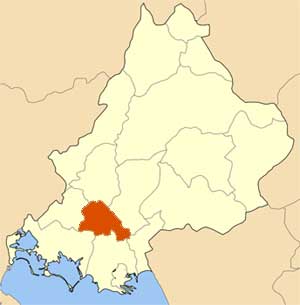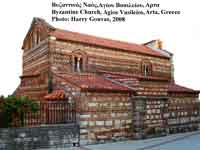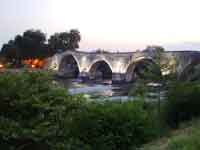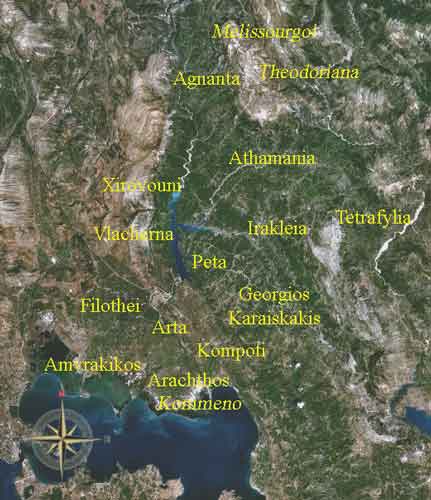.


Administrative Region : Epirus
Regional unit : Arta
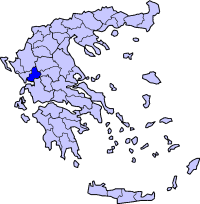
Arta, Arta municipality |
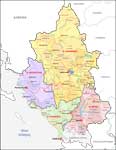
|
Arta (Greek: Άρτα) is a city with a rich history in northwestern Greece, capital of the peripheral unit of Arta, which is part of Epirus region. The city was known in ancient times as Ambracia (Ancient Greek: Αμβρακία). Arta is famous for its old bridge located over the Arachthos River, situated west of downtown. Arta is also known for its ancient sites from the era of Pyrrhus of Epirus and its 13th-century castle, one of the best preserved in Greece. Arta's rich Byzantine history can be also traced today via its many Byzantine churches; perhaps best known is the church of the Panagia Paregoretissa (Mother of God the Consoling), built about 1290 by Despot Nikephoros I Komnenos Doukas. The city is the seat of the Technological Educational Institute of Epirus.
History
The first settlement in the area of the modern city was established in the 9th century B.C. Ambracia was founded by the Corinthians at the 7th century B.C.
Antiquity
Further information: Ancient Greece and Roman Greece
In 295 BC Pyrrhus of Epirus, king of the Molossians, transferred the capital of his kingdom to Ambracia, which he used as a base from which he attacked the Romans. Pyrrhus managed to achieve great but costly victories against the Romans and he became famous for the phrase "Pyrrhic victory" which refers to an exchange at the Battle of Asculum. In 146 BC Ambracia became part of the Roman empire and the province of Epirus was renamed Epirus Vetus, to distinguish it from Epirus Nova to the east. The town is not mentioned under the name of Arta until 1082.
Byzantine/Ottoman Era
Further information: Byzantine Greece and Ottoman Greece
In 1204 after the fall of Constantinople to the Crusaders, it became the capital of the Despotate of Epirus, which extended up to Dyrrhachium and included all of northwestern Greece and regions of Thessaly and northwestern Macedonia. Its founder was Michael I Komnenos Doukas (1205–1215), relative of the imperial Byzantine family of Komnenos. After brief conquests of the city by the Italian dynasty of Orsini (1318–1337), Serbian Empire (1337–1359), Albanian clans (1359–1416) and Italian rulers (Carlo II Tocco, Leonardo III Tocco), the Ottoman Turks conquered it in 1449 and renamed it Narda. It was occupied by Venetians in 1717 and the French in 1797, but the Ottomans retook it in 1799. The city was eventually taken from the Ottomans and annexed to Greece in 1881 by the Treaty of Berlin.
Painting of the Battle of Peta (1822) near Arta, by Panagiotis Zographos under guidance of General Makriyannis. The city of Arta can be seen.
Landmarks
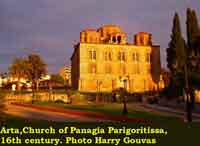
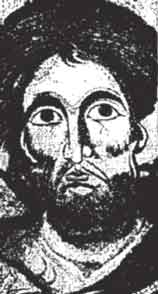
Church of Panagia Parigoritissa and a mosaic
Founded 1285 by Nicephorus I Comnenus Doukas. The current version build by Michael and his wife Anna Palaiologina Kantakouzini. Dimensions approximately 22 m x 20 m
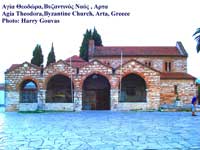
Byzantine Church of Agia Theodora, Arta,
Church of Agia Theodora, Build in the 11th century as a church of St. George, extended around 1270 by Theodora who lived there, in the monastery, after the death of her husband. The grave of St. Theodora in front of the church.
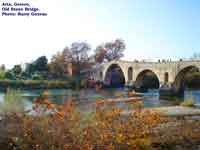
The famous landmark which is over the Arachthos river is Arta's Old Bridge on its west side. The second famous is the ancient buildings. The downtown to its north is surrounded by a state highway.
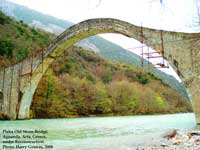
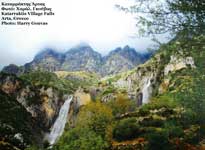
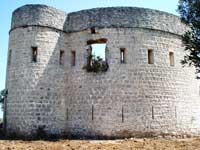
Plaka Old Stone Bridge, Waterfalls, Arta, Ottoman castle of Koronisia, Arta,
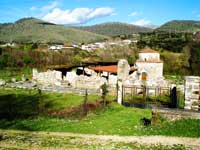
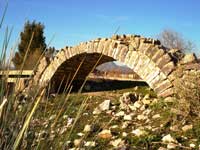
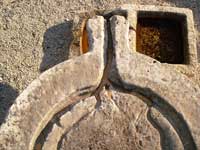
Church Pantanassa, Arta, Roman Bridge, Strongyli, Arta, Roman Olive Press, Strongyli, Arta,
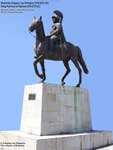
Classical
The modern city is on the site of ancient Ambracia. Remains of the classic era include the ancient walls, the ruins of the ancient temple of Apollo, a small theatre, and remnants of the southwest cemetery.
Byzantine
The castle of Arta was built by Michael II Komnenos Doukas in the middle of 13th century. It is representative of Byzantine architecture and is well preserved. The most important Byzantine church is the Church of the Paregoretissa, that was built during 1285-89 by Nikephoros I Komnenos Doukas and his wife Anna Palaiologina Kantakouzene. The church of Saint Theodora is another fine example of Byzantine architecture. It is dedicated to the protector of Arta and is the only surviving department of the abbey that was founded in the 13th century by the queen of the Despotate of Epirus, Theodora in honour of Saint George, functioning as a nunnery. After the death of her husband, Theodora herself became a nun, and was buried there and the temple is honoured in her name. Other important Byzantine monuments include the churches of Saint Basil (Hagios Vasilios), the Monastery of Kato Panagia, Hagios Vasilios of the Bridge, Panagia Vlaherna, Panagia Brioni in Neohoraki, Saint Demetrius Katsouri in Plisioi, the Red Church in Vourgareli, Panagia of Koronisia in Koronisia and the church of Pantanassa in Filippiada.
Museums
Paregoretissa Church (13th century). In the dining room (Trapeza) there is the Archaeological Collection of Arta.
Archaeological Museum of Arta
Church of the Paregoretissa
Folk museum 'Skoufas'
Historical museum 'Skoufas'
Private folk museum in Kypseli.
Archaeological museum of Koronisia
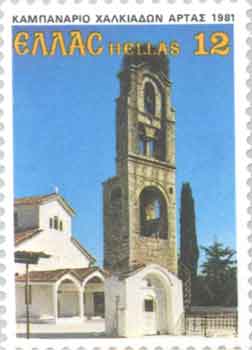
Chalkiades, Arta
Technological Educational Institute of Epirus
The Technological Educational Institute of Epirus (T.E.I.) [1] has a main campus and its administration seat in Arta and has branch campuses in the three other main cities of Epirus, Ioannina, Igoumenitsa and Preveza. It has four (4) Faculties and thirteen (13) Departments.
Transportation
Arta is located NNW of Antirrio, Messolongi and Agrinio, NE of Preveza, SSE of Ioannina and nearly SW of Trikala.
Regular bus lines are connecting Arta with all bigger Greek cities. (bus to Athens departs several times a day and trip takes about 5 hours)
The city is linked with the GR-5 (Antirrio - Ioannina) and the GR-30 which links with Peta and Trikala. The Arachthos River flows to the west with its reservoir lying directly to the north.
Municipality
The present municipality Arta was formed at the 2011 local government reform by the merger of the following 5 former municipalities, that became municipal units (constituent communities in brackets):[1]
Amvrakikos (Aneza, Vigla, Gavria, Kalogeriko, Koronisia, Polydroso, Rachi, Strongyli, Psathotopi)
Arta (Arta, Keramates, Kostakioi, Limini)
Filothei (Agios Spyridon, Kalamia, Kalovatos, Kirkizates, Rokka, Chalkiades)
Vlacherna (Vlacherna, Grammenitsa, Grimpovo, Korfovouni)
Xirovouni (Ammotopos, Dafnoti, Kampi, Pantanassa, Pistiana, Rodavgi, Skoupa, Faneromeni)
Division of the Arta Municipality
- Arta / Δ.δ. Αρταίων [ 21.642 ]
- Arta / η Άρτα [ 19.435 ]
- Agia Trias / η Αγία Τριάς [ 147 ]
- Agioi Anargyroi / οι Άγιοι Ανάργυροι [ 605 ]
- Agios Georgios Glykorrizou / ο Άγιος Γεώργιος Γλυκορρίζου [ 77 ]
- Glykorrizon / το Γλυκόρριζον [ 285 ]
- Eleousa / η Ελεούσα [ 903 ]
- Marathovouni / το Μαραθοβούνι [ 104 ]
- Moni Geniseos Theotokou (or Kato Panagias) / η Μονή Γεννήσεως Θεοτόκου (ή Κάτω Παναγίας) [ 86 ]
- Arta / η Άρτα [ 19.435 ]
- Keramates / Δ.δ. Κεραματών -- οι Κεραμάτες [ 394 ]
- Kostakioi / Δ.δ. Κωστακιών [ 1.508 ]
- Kostakioi / οι Κωστακιοί [ 1.404 ]
- Thanasaiika / τα Θανασαίικα [ 34 ]
- Sygouneika / τα Συγγουνέικα [ 70 ]
- Kostakioi / οι Κωστακιοί [ 1.404 ]
- Limini / Δ.δ. Λιμίνης -- η
- [ 319 ]
Historical population
Year Population
1981 20,004
1991 23,710
2001 23,863
Notable people
Ancient
The ancient king Pyrrhus.
Pyrrhus (318 BC-272 BC), general and king of Epirus
Epicrates of Ambracia (4th century BC), comic poet
Silanus of Ambracia (5th century BC), soothsayer in Xenophon's Anabasis
Epigonus of Ambracia (6th-5th BC), musician
Byzantine
Michael I Komnenos Doukas, founder and first ruler of the principality of Epirus from 1205 until his death in 1215.
Theodore Komnenos Doukas, (died c. 1253), ruler of Epirus from 1215 to 1230 and of Thessalonica from 1224 to 1230.
Theodora Petraliphaina, canonized as Saint Theodora of Arta; (ca. 1225 – after 1270), consort of Epirus and Orthodox Christian saint.
Michael II Komnenos Doukas, ruler of Epirus from 1230 until his death in 1266/68.
Nikephoros I Komnenos Doukas, (c. 1240 – c. 1297) ruler of Epirus from 1267/8 to c. 1297.
Thomas I Komnenos Doukas,(c. 1285–1318) ruler of Epirus from c. 1297 until his death in 1318.
Modern
Maximus the Greek (1475–1556), monk, publicist, writer, scholar, humanist and translator
Nikolaos Skoufas (1779–1818), member of the Filiki Eteria
Georgios Karaiskakis (1780–1827),hero of the Greek War of Independence
Theodoros Tzinis (1798–1869), fighter of the Greek War of Independence
Azmi Ömer Akalın, Wāli of Bursa.[2]
Besim Ömer Akalın, director the Ottoman Red Crescent
Napoleon Zervas (1891–1957), WWII general and resistance leader
Konstantinos Karapanos (1840–1911),political and archaeologist
Alexandros Karapanos (1873–1946), politician and diplomat
Yiannis Moralis (1916), painter
Antonios Nikopolidis (1971), footballer
Yannis Anastasiou (1973), footballer
Professional sports
Handball
http://www.anagenisi-artas.gr
Basketball
Pyrros Artas
Football
http://www.anagenisiartas.gr
http://www.doxa-artas.gr/
Volleyball
http://www.anagenisi-artas.gr/volley
http://www.filia.gr/
See also
Despotate of Arta
Bridge of Arta
Arachthos River
Despotate of Epirus
References
^ Kallikratis law Greece Ministry of Interior (Greek)
^ Özdalga, Elisabeth (2005). Late Ottoman society: the intellectual legacy. Psychology Press. p. 332. ISBN 9780415341646. Retrieved 19 November 2010.
|
Municipalities and communities of the Arta Prefecture
Agnanta | Amvrakikos | Arachthos | Arta | Athamania | Filothei | Georgios Karaiskakis | Irakleia | Kompoti | Peta | Tetrafylia | Vlacherna | Xirovouni |
| Municipal unit Amvrakikos |
|---|
| Community Aneza |
| Aneza (Ανέζα, η) |
| Apomero (Απόμερο, το) |
| Mytikas (Μύτικας, ο) |
| Community Vigla |
| Vigla (Βίγλα, η) |
| Community Gavria |
| Gavria (Γαβριά, η) |
| Community Kalogeriko |
| Kalogeriko (Καλογερικό, το) |
| Community Koronisia |
| Koronisia (Κορωνησία, η) |
| Community Polydroso |
| Palaioskamia (Παλαιοσκαμιά, η) |
| Polydroso (Πολύδροσο, το) |
| Community Rachi |
| Rachi (Ράχη, η) |
| Community Strongyli |
| Strongyli (Στρογγυλή, η) |
| Community Psathotopi |
| Psathotopi (Ψαθοτόπιον, το) |
| Ancient Greece
Science, Technology , Medicine , Warfare, , Biographies , Life , Cities/Places/Maps , Arts , Literature , Philosophy ,Olympics, Mythology , History , Images Medieval Greece / Byzantine Empire Science, Technology, Arts, , Warfare , Literature, Biographies, Icons, History Modern Greece Cities, Islands, Regions, Fauna/Flora ,Biographies , History , Warfare, Science/Technology, Literature, Music , Arts , Film/Actors , Sport , Fashion --- |
Retrieved from "http://en.wikipedia.org/"
All text is available under the terms of the GNU Free Documentation License


